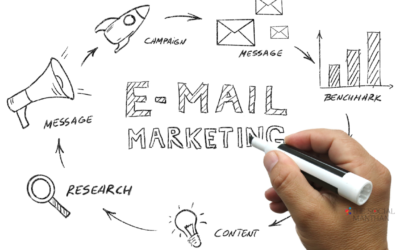ROI is often a key focus when I explore different marketing strategies, and I’ve found that email marketing consistently delivers better results than social media. While social platforms can be fun and engaging, I’ve discovered that email provides a more direct line to my audience, allowing for personalized communication that boosts conversions. In this post, I’ll share insights on why email marketing remains a powerful tool for maximizing your return on investment, even in a world dominated by social media trends.
Key Takeaways:
- Email marketing typically delivers a higher return on investment (ROI) compared to social media platforms due to its targeted nature and direct reach to consumers’ inboxes.
- With email marketing, businesses can segment their audiences and create personalized content, leading to increased engagement and conversion rates.
- Unlike social media, where algorithm changes can impact visibility, email campaigns provide consistent delivery and ownership of the audience, ensuring messages reach the intended recipients.
Email’s Unique Positioning in Consumer Engagement
In the crowded digital landscape, email stands out as a powerful medium for nurturing consumer engagement. With 4 billion daily email users, its personal touch and direct nature facilitate authentic connections. Unlike ephemeral social media posts, emails allow for targeted messaging and create an environment where consumers feel valued and informed. By curating content that resonates with individual preferences, you can drive meaningful interactions, ultimately enhancing loyalty and trust.
The Personal Touch: How Emails Foster Relationships
Emails have a uniquely personal tone that enables genuine communication between you and your audience. When you address subscribers by name or tailor content to their preferences, it establishes a deeper connection. Unlike social media, where interactions can feel superficial, a well-crafted email offers the opportunity to share valuable insights, product updates, and heartfelt messages, making your audience feel truly appreciated.
Targeted Campaigns: Reaching the Right Audience Effectively
Targeted campaigns play a significant role in email marketing’s success, allowing you to hone in on the specific needs and interests of your audience. By leveraging data from previous interactions, you can segment your email lists and deliver tailored content, ensuring your messages resonate. This personalized approach not only boosts engagement rates but also drives conversions, proving that email marketing effectively maximizes your audience reach.
To illustrate this point, consider a clothing retailer that segments its audience based on purchase history and preferences. By sending tailored promotions to specific groups—such as exclusive discounts on activewear for fitness enthusiasts—they see an increase in open rates and sales. Studies show targeted emails average a 26% higher open rate than general emails. This exemplifies the power of reaching the right audience with the right message, ultimately driving greater ROI for your marketing efforts.
The Metrics That Matter: ROI Comparison
| Metric | Email Marketing |
|---|---|
| Average ROI | For every $1 spent, the average return is $42 |
| Click-Through Rate (CTR) | Approximately 2-5% for email marketing |
| Conversion Rate | Up to 10-15% for targeted email campaigns |
| Engagement Rate | Higher than social media, often over 20% |
Email Marketing’s Higher Conversion Rates
Conversion rates tell a powerful story in the battle for ROI. Email marketing typically boasts conversion rates ranging from 10% to 15%, especially for well-targeted campaigns, while social media often struggles to reach beyond 1%. This disparity highlights email’s ability to reach users who are already interested, leading to increased sales and engagement.
Calculating ROI: The Numbers Behind Email vs. Social Media
When examining the ROI of email versus social media, the differences become apparent in hard numbers. For every $1 invested in email marketing, brands can expect an average return of $42. In contrast, social media campaigns may yield less than $10 per dollar spent. Clearly, the mathematics favor email as a more effective channel for generating measurable returns.
In practical terms, calculating ROI involves analyzing both the revenue generated from marketing efforts and the costs associated with those endeavors. For email, this includes software, design, and data management costs, while for social media, expenses can be higher due to ad spend and campaign management. A case in point: a well-structured email campaign targeting an engaged list can drive significant sales without the inflated costs that come with social media advertising. Thus, as I balance these variables, email consistently stands out as a smart choice for maximizing ROI.
A Cost-Effective Channel: The Economics of Email
Email marketing repeatedly proves itself to be a cost-effective channel, delivering impressive returns without breaking the bank. By leveraging existing customer lists and automating campaigns, brands can significantly reduce spending on customer acquisition and retention. With an estimated average ROI of $42 for every $1 spent, email emerges as a financially sensible option compared to many social media tools that often involve higher ad spend without guaranteed results.
Lower Acquisition Costs: Analyzing Budget Efficiency
Acquiring new customers via email is often more efficient than social media platforms, where costs can rise dramatically. By utilizing targeted email campaigns, I can attract and engage users at a fraction of the cost. Studies show that email acquisition costs can be significantly lower than social media ads, especially when nurturing leads through personalized content rather than paying for every click or impression.
Long-Term Value: Nurturing Customer Loyalty
Nurturing customer loyalty through email not only captures immediate sales but also fosters lasting relationships. By delivering meaningful content and impeccable service, I can turn first-time buyers into repeat customers over time, significantly increasing customer lifetime value. The power of personalized, timely communication builds trust, resulting in more predictable revenue streams and lower churn rates.
Developing a long-term loyalty strategy via email allows me to segment campaigns based on customer interests and behaviors, which is key to keeping them engaged. By consistently providing value, whether through exclusive offers, helpful tips, or personalized recommendations, I create a strong bond with my subscribers. Research shows that returning customers contribute up to 50% more revenue than new ones, underscoring the financial benefits of nurturing these relationships through strategic email marketing efforts.
Trends and Innovations in Email Marketing
Innovation in email marketing is rapidly evolving, integrating cutting-edge technology to enhance engagement and ROI. We’re witnessing the rise of interactive emails, which allow recipients to engage directly within their inboxes, thus reducing the friction often faced when clicking through to websites. Additionally, the move towards minimalist designs and mobile optimization caters to the preferences of users who are increasingly checking their emails on-the-go. It’s fascinating to see how these trends are redefining how we communicate with our audiences, ensuring we remain relevant and impactful in our strategies.
Automation and Personalization: The Future of Email
Automation and personalization are no longer optional; they are necessarys in crafting effective email campaigns. Automated sequences triggered by user behavior enable timely and personalized communication that resonates with your audience. By leveraging customer data, you can create targeted emails that speak directly to user needs and preferences, leading to enhanced engagement and conversions.
Leveraging Data for Improved Strategies
Data analytics plays a pivotal role in shaping email marketing strategies. Aggregating insights from campaigns can unveil patterns and preferences among your subscribers, enabling more informed decision-making. For example, A/B testing subject lines and layouts can significantly optimize open and click-through rates. Furthermore, analyzing customer journeys through email interactions allows you to fine-tune your content and frequency, ensuring you’re delivering the right message at the right time. By harnessing data, marketers can continually adapt their strategies for maximum effectiveness and return on investment.
Diving deeper into data analysis can illuminate more than just surface metrics; it reveals the habits and preferences of your audience. Consider using tools that provide insights into peak open times, geographic engagement hotspots, or even customer lifetime value. For instance, discovering that a particular segment of your audience responds better to promotional offers can guide your email content and timing, ensuring you are capturing their attention exactly when they need it. Continuous refinement using this data not only enhances engagement but solidifies relationships, ultimately leading to increased conversions and a stronger ROI.
Real-World Success Stories: Brands Winning with Email
Numerous brands are reaping the rewards of effective email marketing strategies, demonstrating that when done right, this channel can significantly boost sales and customer retention. For instance, brands like Chubbies Shorts have seen an impressive return on investment, leveraging personalized campaigns and segmented email lists to target their audience directly. Their focus on creating engaging content not only drives sales but also fosters community among their customers. This success reinforces the idea that email marketing is not just a tool, but a vital component of any brand’s growth strategy.
Small Businesses Achieving Big Results
Small businesses are proving that email marketing levels the playing field with larger rivals. A local coffee shop, for example, grew its customer base by 40% after launching a targeted weekly newsletter featuring promotions and new products. Creative storytelling in their emails kept subscribers engaged and invested in the brand, reflecting powerful results that highlight the effectiveness of personalized communication.
Enterprises Utilizing Email for Sustained Growth
Leading enterprises are harnessing email to cultivate lasting relationships with customers, resulting in sustained growth and loyalty. One notable case is Starbucks, which has continually expanded its email campaigns by incorporating customer preferences and location-based offers, resulting in a staggering increase in both app usage and in-store sales. They combine behavioral insights with strategic timing, sending well-timed promotions that resonate with their consumer base. This alignment has established a strong connection between the brand and its customers, showcasing how email remains a cornerstone of their marketing efforts.
Conclusion
From above, it’s clear to me that email marketing continues to deliver impressive ROI compared to social media. While social platforms are fantastic for engagement, nothing quite matches the personal touch and direct access that emails provide. I believe you can foster stronger relationships with your audience and drive sales effectively through well-crafted email campaigns. So, if you’re looking to maximize your marketing efforts, consider leveraging email to connect with your customers and watch your returns grow!
FAQ
Q: How does email marketing offer a better return on investment (ROI) compared to social media?
A: Email marketing provides a direct line of communication with customers, allowing businesses to reach their audience more effectively. According to various studies, email marketing can yield an average ROI of $42 for every $1 spent, while social media often falls short in direct sales. This is largely due to the fact that email allows for personalized messaging, targeting specific segments of a customer base, which can lead to higher conversion rates than social media posts, which can be easily overlooked in crowded feeds.
Q: What are the advantages of building an email list over relying on social media followers?
A: Building an email list grants businesses ownership and complete control over their communication channels. Unlike social media platforms, where algorithms can affect visibility and reach, email ensures that messages are delivered straight to the inboxes of subscribers. This not only fosters a more engaged audience but also protects against changes in social media trends or platform policies, allowing for consistent engagement with customers over time.
Q: How can businesses optimize their email marketing strategies for better ROI?
A: To optimize email marketing for better ROI, businesses should focus on segmenting their audience to tailor content effectively, thereby increasing relevance and engagement. Additionally, utilizing A/B testing on subject lines, content, and send times can help identify what resonates best with recipients. Ensuring that emails are mobile-friendly and visually appealing also plays a significant role in improving open and click rates, ultimately enhancing the overall effectiveness of email campaigns.






